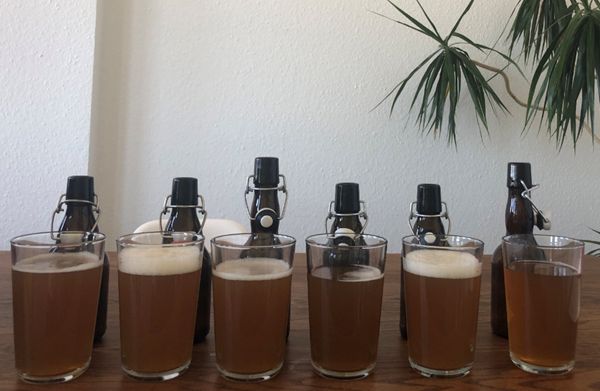
Background
When making some recipes, sugar additions are made in the form of sugar syrups or dark sugars. These additions obviously bring more alcohol to the beer, but how much flavour do they impart?
Aim
Compare beers made from the same wort but with different sugar additions.
Method
A simple malt bill of 50% Pilsner and 50% Munich dark was used, with Magnum as the bittering hop. No other hop additions were made to focus on the flavour form the various sugar additions.
The wort was split into 6 bottles with different syrup/sugar additions:
1) Reis syrup
2) Agaven Dicksaft dunkel
3) Agaven Dicksaft
4) Goldsaft
5) Kokobluten sugar
6) Control
Once the fermentation appeared to be finished samples of the beers were collected for analysis in the Quantos and the beers were bottled with 5g per litre of sugar and left to carbonate and condition for 2 weeks before the taste test.
Results and discussion:
Taste test
I have to say, this was not the best tasting collection of beers. Quite a large addition was made of the sugar solutions to really try to pull out the flavour they brought to the beers but it was too much. Any who, five lucky tasters tested the beer for us and these are their comments:
1) Something missing/not as full flavoured as the others/unbalanced
2) Citrusy/Belgium twang/more taste than the 1st/ok flavour
3) Belgium twang/better than 4 but not great/metallic taste
4) Slightly bitter/Belgium twang/bitter and sweet but with no middle/least favourite
5) Cidery/fruity/sweeter, more complex than the others
6) Likeable, plain beer/compared to the others not distinctive
So basically, the control was the best.
The science stuff

We have only compared the gravities and alcohols of this collection as these affected the taste the most.
Summary and after thoughts
The first point to mention is that this test was really not equal. By not equalising the starting gravity the alcohol level of the finished beers is very different. This experiment should be repeated (although perhaps with a few different sugar/syrup additions) and they should begin with the same starting gravity. I think in terms of alcohol, 7.5% is a good level to aim for. Also, white sugar should be used as the neutral control or as an additional one.
But we did learn some interesting things. Putting this much sugar into the beers really unbalanced the flavour. Also, some of the beers did not actually finish fermenting and as time went on the bottles became more active when opened. Some of these syrups are produced by using enzymes so it could be that these were still active to some degree and continued their work on some of the non-fermentable sugars in the wort. Next time, these would need to be heat treated before adding to the wort. But it could also just be that the yeast where running out of nutrients, so next time an addition of yeast nutrient could also be better.
Thank you for reading the second of what we hope to be many blogs investigating the brewing process of beer, the fermentation of wines, country wines, ciders, meads and all the interesting drinks that fall somewhere in between. If you have any comments or you would like to suggest something to investigate get in touch with us at: brewingdeconstructed at qfood.info



